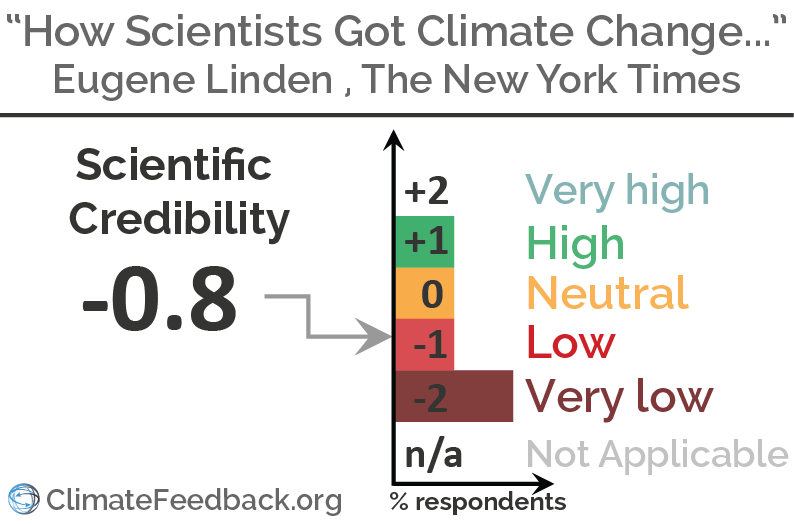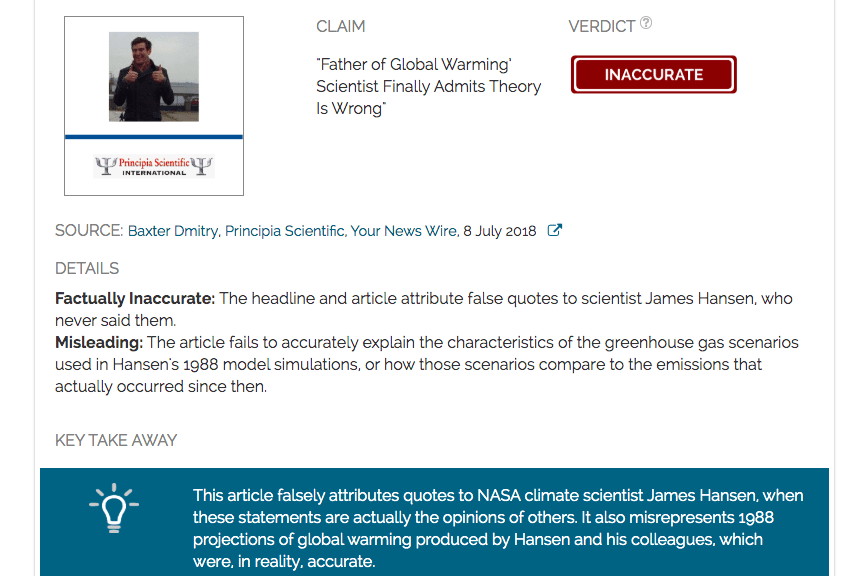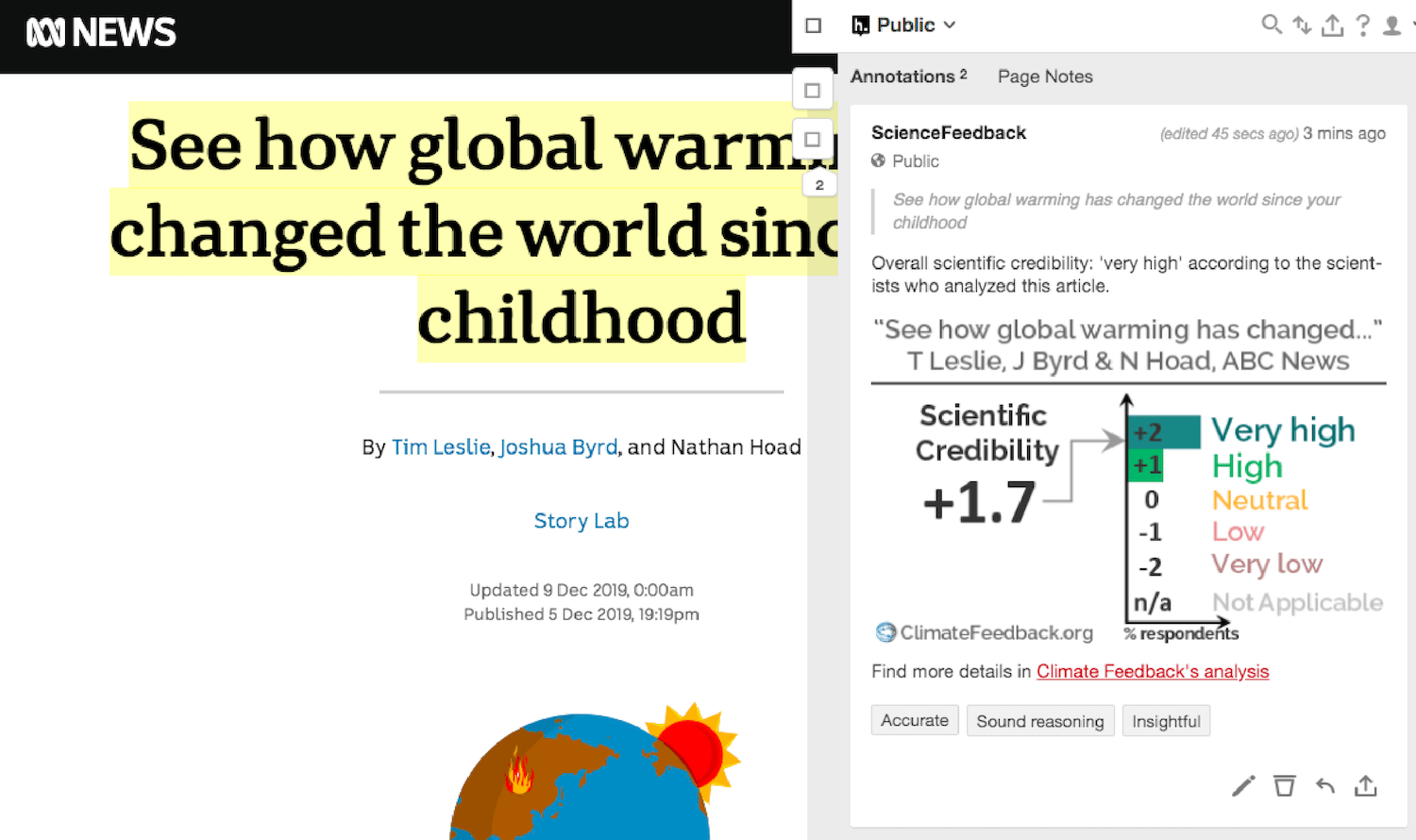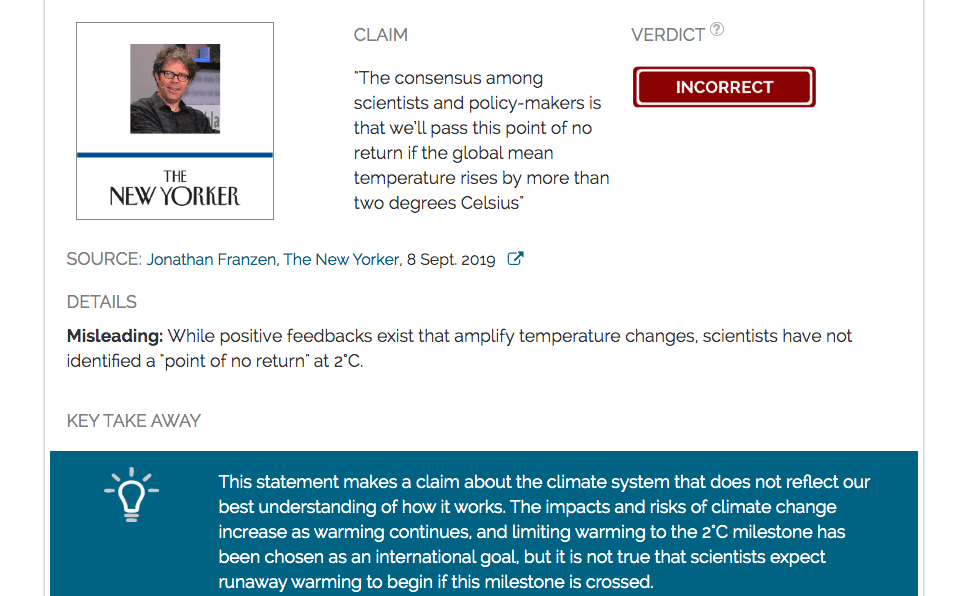- Climate
New York Times op-ed claiming scientists underestimated climate change lacks supporting evidence
Reviewed content

Headline: "How Scientists Got Climate Change So Wrong"
Published in The New York Times, by Eugene Linden, on 2019-11-08.

Scientists’ Feedback
SUMMARY
This op-ed by author Eugene Linden, published under the headline “How Scientists Got Climate Change So Wrong”, argues that climate scientists have long underestimated climate change. The article discusses the state of science as far back as the 1950s but focuses on the period since the 1990s, claiming that we are now seeing climate impacts previously thought to be far in the future.
Scientists who reviewed the article found that some of the evidence used to support this argument is based on a misrepresentation of the state of scientific knowledge at points in the past. Although the article discusses some topics accurately, such as noting advances in the understanding of ice sheets over the years, it fails to acknowledge many long-accurate predictions that show how useful climate projections have been in warning of the impacts of climate change.
In the annotations below, scientists highlight specific reports and studies that don’t match the descriptions given in the article. For example, the article states that the First Assessment Report of the Intergovernmental Panel on Climate Change, published in 1990, concluded that “climate change would arrive at a stately pace”. But if anything, that report projected slightly more rapid warming than what the Earth has experienced so far—partly because humans have emitted a little less greenhouse gas than the scenario used in the report to project warming.
See all the scientists’ annotations in context. You can also install the Hypothesis browser extension to read the scientists’ annotations in context.
GUEST COMMENTS

Research Geologist, (views are my own)
The main flaw in the author’s argument that scientists have “underestimated” the rate and severity of climate change is that the author predominantly points to recent extreme events as evidence of what scientists “failed to predict” (such as the heat wave that extended into the Arctic and drove rapid melting of the Greenland Ice Sheet or recent hurricanes). The author implies that scientists did not give the public fair warning about the potential of such events. Firstly, scientists cannot predict the particular extreme events that will unfold decades in the future. What they can and did do (quite accurately in the IPCC assessments) is to provide estimates for long-term projections based on the best available data and models. Against this long-term backdrop of global change will inevitably be the local and regional-scale extreme events and tipping points that are inherently difficult to predict. The author cites one such consensus report from nearly 2 decades ago: “Abrupt Climate Change: Inevitable Surprises”, which in the very title conveys this basic message—climate change will manifest in abrupt and surprising ways.
Abrupt climate change by its very nature is difficult to predict. Despite this inherent difficulty, there has been scientific research and progress in trying to assess the likelihood of certain tipping points1. And to try and anticipate early warning signs prior to critical transitions. For example, this study2 and a more recent report from 2013: “Abrupt Climate Change: Anticipating Surprises”3.
Secondly, while I do agree that awareness of abrupt climate change and the ways in which long-term changes will increase the severity and probability of extreme events is generally lacking among the wider public, to somehow blame this on the scientists who have been working to understand and disseminate this knowledge for decades is a complete mislocation of blame. The author completely neglects the wider social and political context through which perception of scientific understanding and climate action/adaption has occurred.
None of this is to say that scientists knew everything and got it all right decades ago. Of course they didn’t. To quote the author, “Science is a process of discovery. It can move slowly as the pieces of a puzzle fall together and scientists refine their investigative tools.” So, yes, scientists are still actively working to understand more about the dynamics of abrupt climate and potential ways to anticipate inherently “unpredictable” phenomena, all while trying to keep up with the pace of climate change.
- 1- Lenton et al (2008) Tipping elements in the Earth’s climate system, PNAS
- 2- Scheffer et al (2012) Anticipating Critical Transitions, Science
- 3- Abrupt Impacts of Climate Change: Anticipating Surprises, US National Academy of Sciences
REVIEWERS’ OVERALL FEEDBACK
These comments are the overall assessment of scientists on the article, they are substantiated by their knowledge in the field and by the content of the analysis in the annotations on the article.

Research Associate, Harvard University
In my view, this article misrepresents the history of climate science (in particular, what was known from the 70s to 90s) to try to make up a case that climate scientists “got climate change so wrong”, i.e., completely underestimated its pace and amplitude. I found numerous factual errors and mis-interpretations in this presentation. The reality is, since at least the 80s, climate scientists have been making broadly consistent projections (to whomever was listening). The observed pace of warming is on par with these projections—not faster. What’s true is that some impacts of that warming are happening faster than initially anticipated. That includes the melting of polar sea ice and ice caps. The author here focuses a lot on these aspects, but these are just one aspect of climate change, amongst many others—for which changes are unfolding essentially as expected. So, overall, to me this article presents an incomplete and biased view of climate change. I found the title, in particular, very problematic (it may not have been written by the author, though, but instead by the paper).

Researcher, Agricultural Sustainability Institute, University of California, Davis
Most of the specific facts and statistics in this op-ed are correct, but the overall effect is significantly misleading. The author’s central point is that scientists have been drastically underestimating the scope and the pace of climate change until just the past decade or so, and recent events such as permafrost melting, ice cap loss, and extreme weather events have caught them by surprise. This is simply not true.
Predictions on the overall pace of global warming, and on its specific effects, have been quite consistent (and broadly accurate) since at least 1990, and in some cases since the late 1970s. For example, the cover story of TIME Magazine on October 19, 1987 was titled “The Heat is On.”1 This article warned the American public that “man-made contributions to the greenhouse effect, mainly CO2 that is generated by the burning of fossil fuels, may be hastening a global warming trend that could raise average temperatures between 2 degrees F and 8 degrees F by the year 2050.” That is, if anything, somewhat higher than current predictions.
Similar critiques can be made of Mr. Linden’s claim that economists were universally unconcerned about the costs of climate change. Even in the late 1990s and early 2000s, that was not true. He cites William Nordhaus to make his point, but he doesn’t cite any other economic damage estimates, such as those made by Richard Tol in 20021 or, even more on the pessimistic end, Nicholas Stern in 20062.
I especially object to the article’s title: “How Scientists Got Climate Change So Wrong.” It implies that inaction on climate change can largely be blamed on unimaginative scientists conforming to a status quo belief that climate is nearly immovable and human perturbations are insignificant. According to Linden, scientists didn’t think “abrupt climate change” was possible until the publication of some Greenland ice core data in the mid-1990s and a paleoclimate summary report in the early 2000s. That is not really true. Scientists were sounding the alarm about rapid anthropogenic climate change as early as the late 1970s. (I studied with climatologist Stephen Schneider at Stanford in the late 1990s, and he was just as concerned about climate change then as he was a decade later.) This ongoing calamity, in which climate scientists presented well-grounded and deeply worrying predictions to policymakers only to be ignored, was described very well in another NY Times article, “Losing Earth: The Decade We Almost Stopped Climate Change“.
Mr. Linden’s goal with this op-ed may have been to drum up increasing public concern for climate change. If so, that is a worthy goal, but I believe he is going about it in the wrong way—by criticizing climate scientists for their supposed timidity and failed predictions, when in fact climate scientists have presented a remarkably consistent series of predictions for at least the past three decades (even if those predictions have fallen on deaf ears).
- 1- Tol (2002) Estimates of the Damage Costs of Climate Change, Part II. Dynamic Estimates, Environmental and Resource Economics
- 2- Stern et al (2006) Stern Review: The Economics of Climate Change, HM Treasury

Assistant Professor, University of Virginia
This article sheds light on how the “worst case” scenarios for future climate and sea level could be worse than previously modeled. The presented science is largely accurate and supports current peer-reviewed scientific literature on the topic. In a few cases, clarification or disclaimers are needed to reflect uncertainty in the current state of ice sheets and their contributions to sea level as some statements in the article portray definitive certainty when that is not entirely the case.

Assistant Research Professor, University of Minnesota
To blame the very scientists who identified global warming and continue to monitor its impacts across the world, while ignoring the active efforts in support of disinformation is grossly irresponsible. The author cites many facts, for instance about Antarctic glaciology, but omits important details that expand the timeline of research and warnings back 40 years.
Notes:
[1] See the rating guidelines used for article evaluations.
[2] Each evaluation is independent. Scientists’ comments are all published at the same time.
Annotations
The statements quoted below are from the article; comments are from the reviewers (and are lightly edited for clarity).
How Scientists Got Climate Change So Wrong
Few thought it would arrive so quickly. Now we’re facing consequences once viewed as fringe scenarios.

Research Associate, Harvard University
This is not factually correct. Global warming projections have been essentially the same since at least the Charney report in 19791, and even before that (in the sense that the central estimate of climate sensitivity to CO2 is still the same). Overall warming has proceeded in the real world essentially as projected—not slower, not faster. Many predicted aspects of climate change, such the spatial and temporal pattern of that warming (e.g. more warming over land and at higher latitudes), changes in the water cycle, in extremes events, etc.. are also borne out in observations, at least qualitatively.
What’s true is that some impacts of the warming on polar ice, such as decrease in Arctic sea ice, melting of the ice caps in Greenland and Antarctica, are happening faster than predicted early on—but that’s essentially because knowledge of these systems was very limited at the time (and thus predictions were very cautious).
Overall it seems to me, if one tries to be objective, that scientists got climate change right for the most part—so far.
- 1- National Research Council (1979) Carbon Dioxide and Climate: A Scientific Assessment

Researcher, Agricultural Sustainability Institute, University of California, Davis
I agree with Alexis Berg regarding the overall premise of this piece. Overall, climate scientists’ predictions have, on average, been roughly correct for quite a few decades now. This opinion piece by Eugene Linden seems to selectively present historical predictions that turned out to be underestimates, while ignoring those that were right-on or even overestimates. For example, in 1979, James Hansen and others made an educated guess that global temperatures would increase by about 3°C in 2035. That (fortunately) looks like it will turn out to be a significant overestimate.
For decades, most scientists saw climate change as a distant prospect. We now know that thinking was wrong.

Research Associate, Harvard University
I am not sure what “decades” this is about. Perhaps in the 60s and 70s. But ever since modeling studies and projections began in earnest, e.g. in the 80s and 90s, projections have indicated significant warming by, for example, 2100.

Scientist, University of Bonn, Germany
More than two decades ago (in 1997), Eugene Linden wrote: “Scientists have assumed that any change caused by humans would occur over many decades. They are no longer so sure.” There is some wiggle room, but these two claims mostly do not match.
Had a scientist in the early 1990s suggested that within 25 years a single heat wave would measurably raise sea levels, at an estimated two one-hundredths of an inch, bake the Arctic and produce Sahara-like temperatures in Paris and Berlin, the prediction would have been dismissed as alarmist.

Research Associate, Harvard University
Actually, climate models from the first IPCC report in 1990 were projecting more warming than subsequent reports (I believe because they didn’t account for aerosols at the time, which cool the climate, overestimated future CO2 emissions, and didn’t account for ocean dynamics).

Researcher, Agricultural Sustainability Institute, University of California, Davis
The IPCC absolutely was predicting significant and relatively rapid warming in its first report in 1990. Their best estimate was 0.3°C per decade throughout the 21st century (thus, 3.3°C by 2100) under “business as usual emissions,” which of course are higher now than they were then. This is comparable with current estimates.
Furthermore, the danger was being reported in the popular press even earlier than 1990. For example, on October 19, 1987, TIME Magazine ran a cover story titled “The Heat is On.” A key quote from that article, paraphrasing climatologist Stephen Schneider, states that “man-made contributions to the greenhouse effect, mainly CO2 that is generated by the burning of fossil fuels, may be hastening a global warming trend that could raise average temperatures between 2 degrees F and 8 degrees F by the year 2050.” That is not exactly a “stately pace.”

Scientist, University of Bonn, Germany
Which would have been fair if our understanding of the climate system was not yet sufficient 25 years ago to predict whether heat waves would become worse and by how much. That is not a trivial question, local heat waves are not just determined by the global annual mean temperature.
But in the case of climate, this deliberation has been accompanied by inertia born of bureaucratic caution and politics.

Scientist, University of Bonn, Germany
No evidence provided.
A recent essay in Scientific American argued that scientists “tend to underestimate the severity of threats and the rapidity with which they might unfold” and said one of the reasons was “the perceived need for consensus.”

Assistant Professor, University of Virginia
The current IPCC projections are not intentionally underestimated. We are still at a stage of discovering new processes that are important to the ice-ocean-climate system. Therefore, taking a step forward of being able to incorporate important processes in models, to varying degrees, limits the uncertainty and magnitude of future changes. For example, recent numerical model work by Robel et al1 has demonstrated the importance of a single ice-destabilizing process in sea-level projections that can increase the magnitude and uncertainty in sea-level scenarios. This is just one example of how a single process or condition impacts the (un)certainty in future sea levels and thus limits community planning that takes into account a large range of scenarios, in particular the high-end scenarios that will be more costly for mitigation infrastructure.
- 1- Robel et al (2019) Marine ice sheet instability amplifies and skews uncertainty in projections of future sea-level rise, PNAS
In 1990, the Intergovernmental Panel on Climate Change, the United Nations group of thousands of scientists representing 195 countries, said in its first report that climate change would arrive at a stately pace

Research Associate, Harvard University
This is simply false. Quoting the summary for policy makers from that first report in 1990: “Based on current models, we predict: under business-as-usual, increase of global mean temperature during the [21st] century of about 0.3 °C per decade (with an uncertainty range of 0.2 to 0.5 °C per decade); this is greater than that seen over the past 10,000 years; under other … scenarios which assume progressively increasing levels of controls, rates of increase in global mean temperature of about 0.2 °C [to] about 0.1 °C per decade.”
Like I mentioned above, these early models were actually running even hotter than current models.
[The 1990 IPCC report said] that the Antarctic ice sheets were stable

Assistant Professor, University of Virginia
Although this was the conception, the idea that the Antarctic ice sheet was stable in the 1990s largely stems from a lack of continental scale observations provided by remote sensing and a lack of widespread in situ, on-ice observations. Therefore, late 20th century thought about a stable Antarctic ice sheet stemmed from negative evidence, rather than positive evidence supported by observations.

Research Associate, Harvard University
Again, technically, not true. The report summary indicates that: “The West Antarctic Ice Sheet is of special concern. A large portion of it containing an amount of ice equivalent to about 5m of global sea level, is grounded far below sea level. There have been suggestions that a sudden outflow of ice might result from global warming and raise sea level quickly and substantially”.
The report concludes that: “Within the next century it is not likely that there will be a major outflow of ice from West Antarctica due directly to global warming”—but not that it is “stable”.
That report also emphasized uncertainties in that respect a whole lot.

Assistant Research Professor, University of Minnesota
As Lauren also highlights, the IPCC has struggled to represent the possibility of more rapid collapse of the Antarctic ice sheet, particularly West Antarctica. Antarctica was viewed as more stable before the continent-scale satellite observations beginning in the 1990s and improved glaciological observations. However, Mercer gave a strong, clear warning in the journal Nature in 19781, with the article “West Antarctic ice sheet and CO2 greenhouse effect: a threat of disaster.” His predictions remain a central paradigm in Antarctic glaciology and scientists from the US and UK are currently rushing to the most vulnerable glacier in Antarctica—Thwaites Glacier—to further clarify how much sea level rise may come from this location, and importantly, how fast. The amount of ice at play here is on the order of 10 feet of global mean sea level equivalent.
- 1-Mercer (1978) West Antarctic ice sheet and CO2 greenhouse effect: a threat of disaster, Nature
Relying on the climate change panel’s assessment, economists estimated that the economic hit would be small

Research Associate, Harvard University
The low economic costs of global warming estimated by, for example, W. Nordhaus, have more to do with his methodology (the DICE model and its damage function) than with climate projections themselves. Like I said, models at that time indicated even faster warming.

Researcher, Agricultural Sustainability Institute, University of California, Davis
Not all economists. For example, in the late 1990s and early 2000s, widely cited economist Richard Tol published analyses indicating that doubled CO2 would probably cost at least 0.6% of global GDP by 2100, and quite possibly as much as 1.2% of GDP if climate sensitivity was worse than expected or adaptation was less successful than anticipated1.
- 1- Tol (2002) Estimates of the Damage Costs of Climate Change, Part II. Dynamic Estimates, Environmental and Resource Economics
all of those predictions turned out to be completely wrong

Research Associate, Harvard University
Highly misleading. The author just focused on a subset of predictions (i.e., ice cap stability), and/or, as I indicated above, misrepresented them. Saying “all of those predictions” is thus highly misleading.

Researcher, Agricultural Sustainability Institute, University of California, Davis
Alexis Berg is correct: to say “all these predictions were completely wrong” is a highly exaggerated and cherry-picked conclusion on the author’s part. Most climate predictions from the 1990s have been more or less borne out so far.
So far, the costs of underestimation have been enormous.

Scientist, University of Bonn, Germany
No evidence provided on whether this was the cost of underestimation or lack of climate action.
Hurricane Harvey gave Houston and the surrounding region a $125 billion lesson about the costs of misjudging the potential for floods

Scientist, University of Bonn, Germany
This sentence claims that all of the costs of Harvey should be ascribed to science and none of it to Texas or federal politicians, nor to the media.
The climate change panel seems finally to have caught up with the gravity of the climate crisis

Research Associate, Harvard University
This is a bit rich, given that the IPCC is precisely the reason we all know about the climate crisis… more to the point, warming projections since the 90s and the first IPCC report have essentially been the same. What has changed is that it is now 2020, and the time window to cut emissions and limit warming to 2°C globally is closing down.
Unfortunately, this dose of reality arrives more than 30 years after human-caused climate change became a mainstream issue.

Research Associate, Harvard University
This is misleading and, to be honest, a bit frustrating, given that 5.4°F warming is precisely the warming the IPCC has warned all along (since the 90s) would happen under business-as-usual emissions. The UN is simply restating that this is where we are currently headed.

Researcher, Agricultural Sustainability Institute, University of California, Davis
Alexis Berg is right again. This value (5.4°F or 3.4°C of warming) is in line with what has consistently been predicted for the past 30 years.
Conventional wisdom, in the 1950s, on the pace of major climate change: 8,000 years Each large square = 100 years 1960s through the ’80s: Centuries or millenniums 1990s to today: 5 to 50 years

Research Associate, Harvard University
While this graphic may apply to natural climate variations, I would argue that it doesn’t really apply to current, man-made climate change, in the sense that since at least the 70s scientists understood that climate would respond to human CO2 emissions within decades (i.e., not millennia as implied by that graph).

Researcher, Agricultural Sustainability Institute, University of California, Davis
It is not true that climate scientists in the 1970s and 1980s thought that any significant climate changes would take centuries or millennia. On the contrary, 30-40 years ago, the predictions on the extent and pace of climate change were very similar to today’s predictions. This was reviewed exhaustively in another recent NY Times article, “Losing Earth“. Here are a couple representative quotes:
“[A 1978 EPA report warned that] fossil fuels might, within two or three decades, bring about “significant and damaging” changes to the global atmosphere.”
“[In 1979, a team of scientists calculated that] when carbon dioxide doubled in 2035 or thereabouts, global temperatures would increase between 1.5 and 4.5 degrees Celsius, with the most likely outcome a warming of three degrees.”
The evidence in those ice cores would prove pivotal in turning the conventional wisdom. As the science historian Spencer Weart put it: “How abrupt was the discovery of abrupt climate change? Many climate experts would put their finger on one moment: the day they read the 1993 report of the analysis of Greenland ice cores. Before that, almost nobody confidently believed that the climate could change massively within a decade or two; after the report, almost nobody felt sure that it could not.”

Research Associate, Harvard University
This whole section of the article somehow implies that when scientists found out about abrupt climate change events during the last glacial era (i.e., the Younger Dryas event, and Dansgaard–Oeschger events) is when they fully realized climate could change by 2100 rapidly in response to CO2. I don’t believe this perspective is correct. Abrupt climate swings in the last glacial era are not really relevant to our current, interglacial climate (in which they don’t happen), and the projected climate response to CO2 emissions does not involve such processes.
In 2002, the National Academies acknowledged the reality of rapid climate change in a report, “Abrupt Climate Change: Inevitable Surprises”

Researcher, Agricultural Sustainability Institute, University of California, Davis
I do not think it is well justified to tie the publication of this 2002 paleoclimate report to a sudden supposed epiphany in the scientific community about how modern emissions of greenhouse gases would affect global temperature. As Alexis Berg and I have said repeatedly above, climate scientists’ warming predictions have generally been right on track, and have not changed much for the past 30-40 years.
(In fact, Swedish chemist Svante Arrhenius described the basic cause and effect of fossil-fuel-induced climate change back in the 1890s. That is not a typo—Arrhenius made a roughly correct quantitative calculation 130 years ago.)

Scientist, University of Bonn, Germany
The title of the report alone shows that science did warn that taking the climate system into uncharted territories is dangerous. Specific warnings can only be given once a problem is understood.
And even today, 17 years later, a substantial portion of the American public remains unaware or unconvinced it is happening.

Scientist, University of Bonn, Germany
Science is a global enterprise as knowledge is universal.
That the denial of the reality is an Anglo-American phenomenon suggests that the main problem is not science, but American political problems and the US-Australian media.
In the early 2000s, ice shelves began disintegrating in several parts of Antarctica, and scientists realized that process could greatly accelerate the demise of the vastly larger ice sheets themselves.

Assistant Professor, University of Virginia
Antarctic ice shelf collapse is documented from the mid-1990s onward1,2.
- 1- Vaughan and Doake (1996) Recent atmospheric warming and retreat of ice shelves on the Antarctic Peninsula, Nature
- 2- Scambos et al (2003) Climate‐induced ice shelf disintegration in the Antarctic Peninsula, in Antarctic Peninsula Climate Variability: Historical and Paleoenvironmental Perspectives

Assistant Research Professor, University of Minnesota
Again, Mercer gave a strong, clear warning on this in 1978, with the article “West Antarctic ice sheet and CO2 greenhouse effect: a threat of disaster.”1 He predicted a southward migration of ice shelf collapse, and eventually an irreversible collapse of the West Antarctic ice sheet. This concept was revisited and reconfirmed in 2009 by Bamber et al2.
- 1-Mercer (1978) West Antarctic ice sheet and CO2 greenhouse effect: a threat of disaster, Nature
- 2- Bamber et al (2009) Reassessment of the Potential Sea-Level Rise from a Collapse of the West Antarctic Ice Sheet, Science
By 2014, a number of scientists had concluded that an irreversible collapse of the West Antarctic ice sheet had already begun

Assistant Professor, University of Virginia
It is generally true that conditions are suitable for irreversible collapse of the West Antarctic ice sheet via the process called “Marine Ice Sheet Instability” where an initial forcing of ice sheet retreat progresses inland due to a landward-sloping bed that forces marine-based ice sheets to retreat into yet deeper and deeper water. However, there are potential brakes that could halt this ‘irreversible’ retreat including bumps in the bed topography that the ice is sitting on top of that can act as pinning points as well as increased lateral drag at the ice margins that can slow down ice flow and retreat1,2. However, bed topography beneath the ice is not well-resolved and the jury is still out on whether current retreat is truly irreversible.
- 1- Jamieson et al (2013) Understanding controls on rapid ice‐stream retreat during the last deglaciation of Marguerite Bay, Antarctica, using a numerical model, Journal of Geophysical Research: Earth Surface
- 2- Gudmundsson et al (2012) The stability of grounding lines on retrograde slopes, The Cryosphere
As recently as 1995, [permafrost] was thought to be stable.

Research Associate, Harvard University
Not accurate. The 1990 IPCC report indicates for instance that:
“Higher temperatures could increase the emissions of methane at high northern latitudes from decomposable organic matter trapped in permafrost and methane hydrates ”
and
“Time-scales for thawing the permafrost […] could be decades to centuries, ”
For all of the missed predictions, changes in the weather are confirming earlier expectations that a warming globe would be accompanied by an increase in the frequency and severity of extreme weather.

Researcher, Agricultural Sustainability Institute, University of California, Davis
This is actually one of the most difficult aspects of climate change to predict and correctly attribute. Storm behavior is more complicated and harder to model than changes in average temperature or precipitation. Some aspects of “extreme weather” (e.g. number of Category 5 tropical cyclones) may be expected to increase with global warming, but others (e.g. total number of tropical cyclones, or total number of tornadoes) may not be. So it’s best to proceed with caution when tying climate change predictions to extreme weather events.



